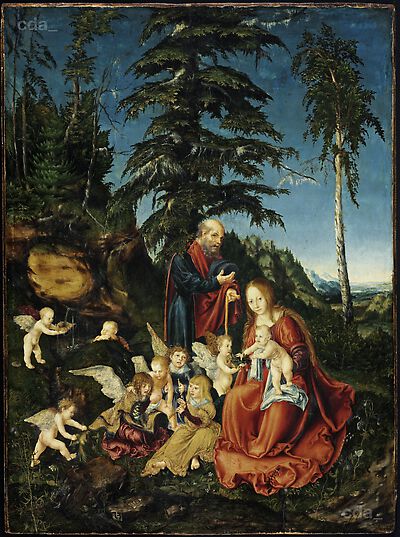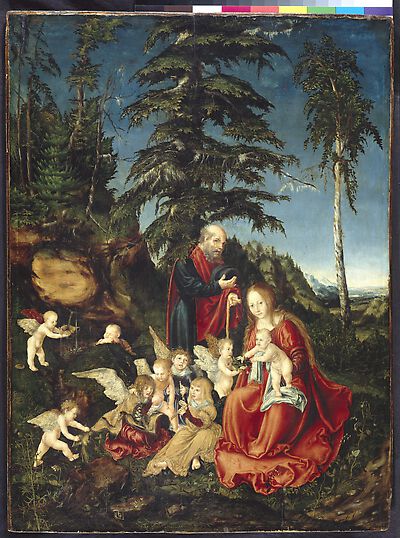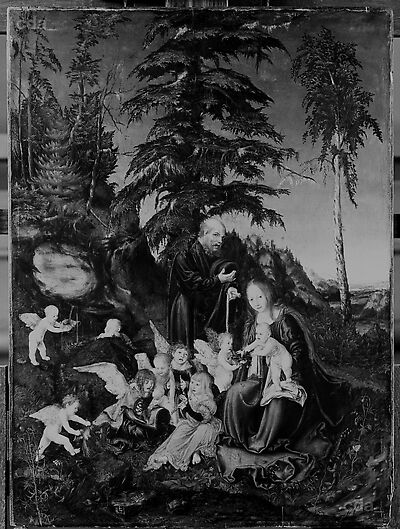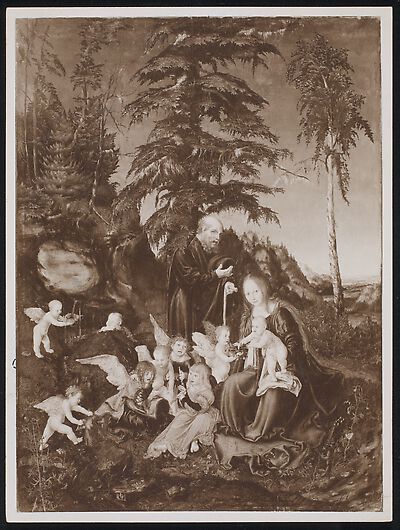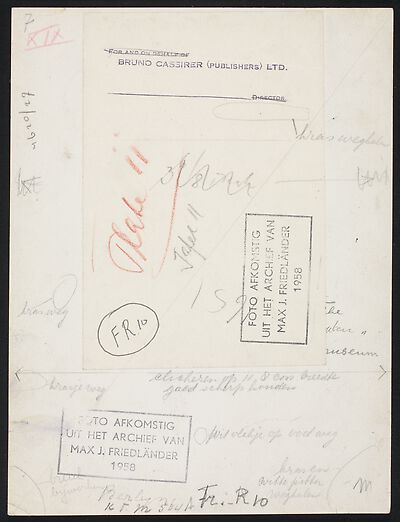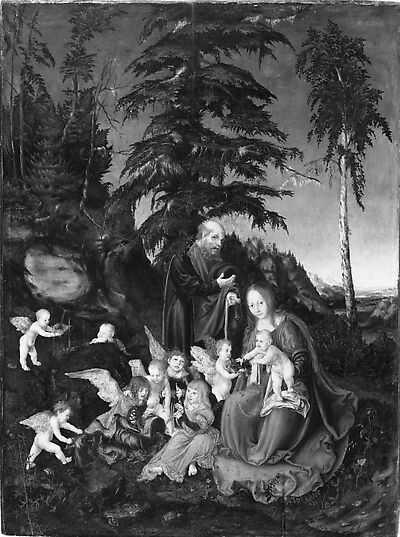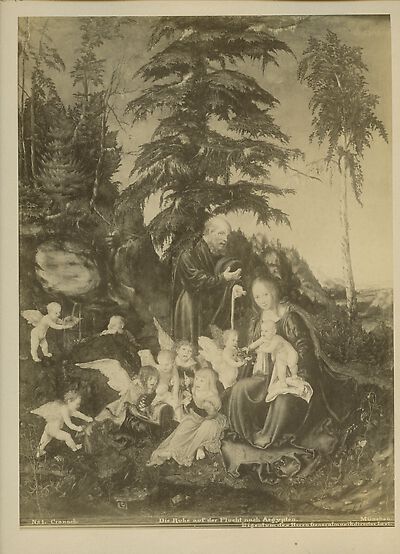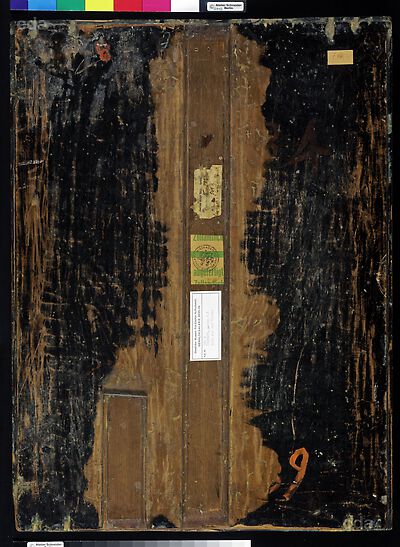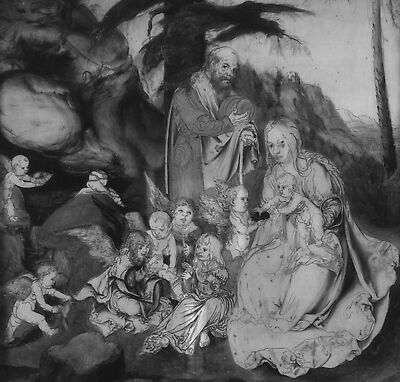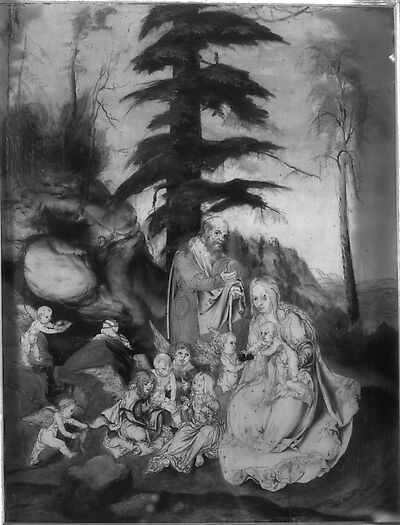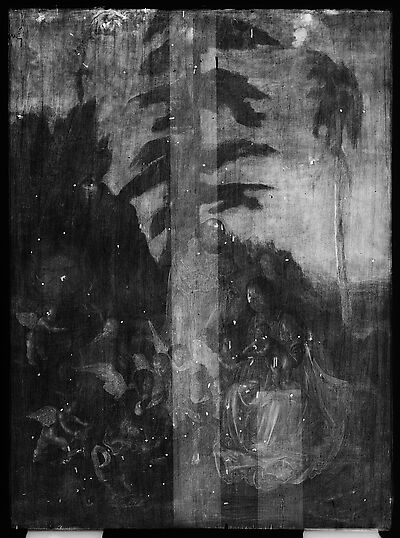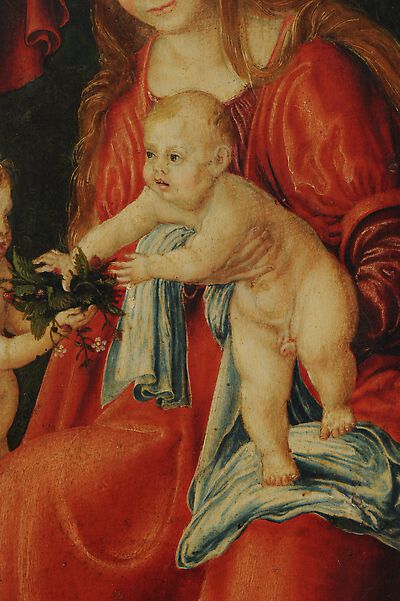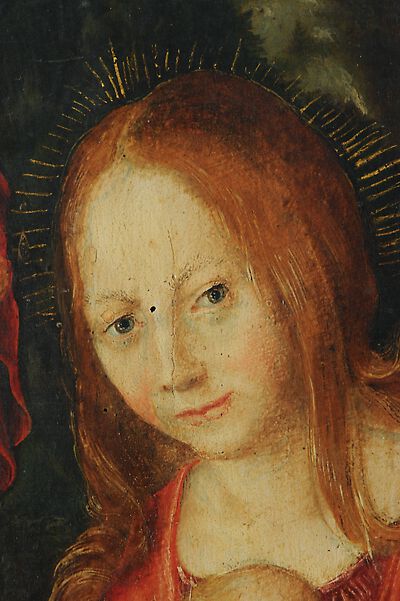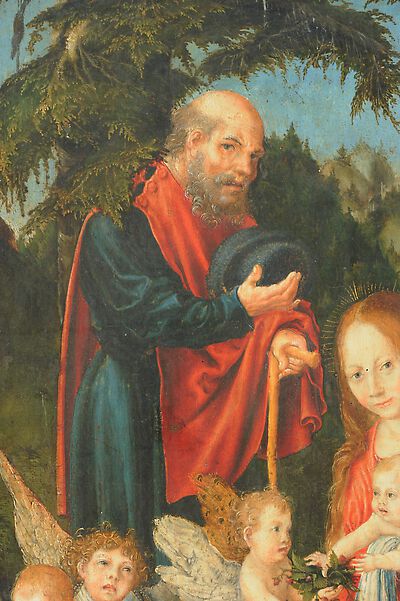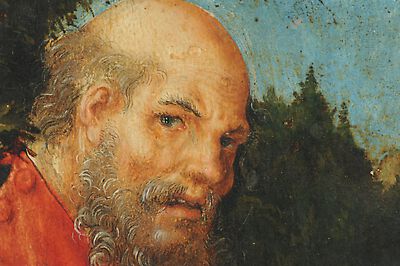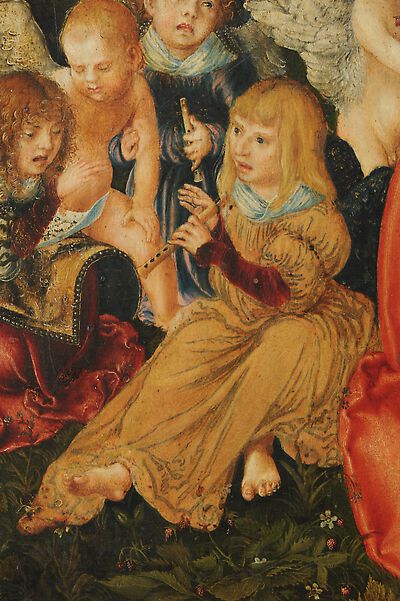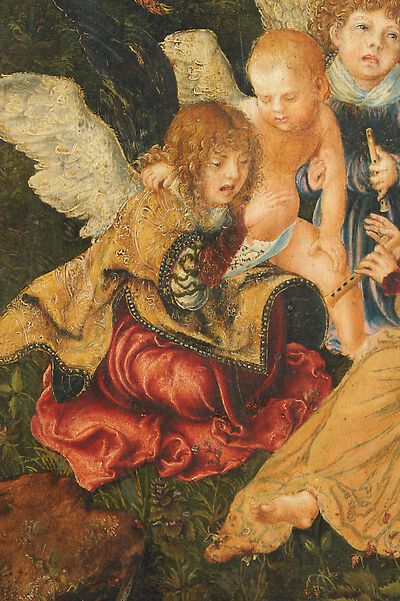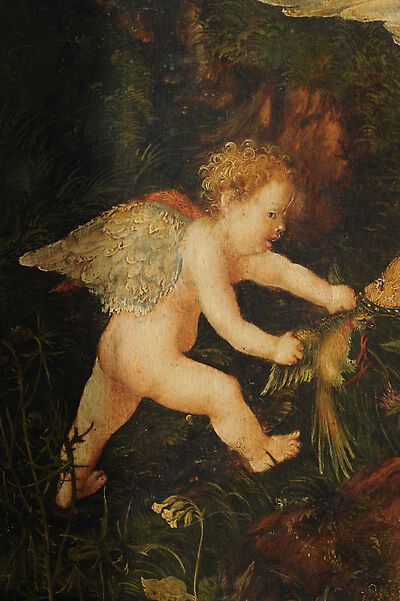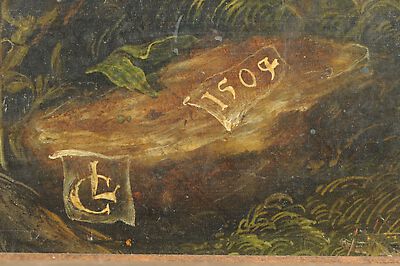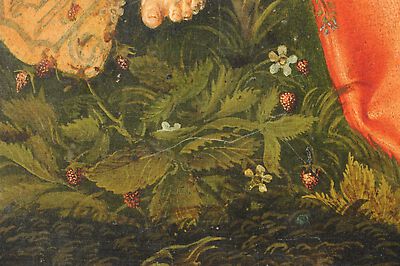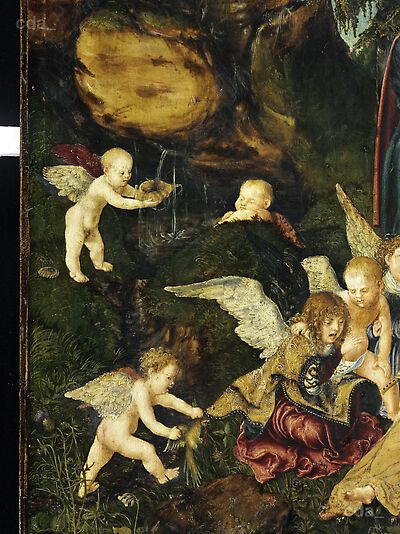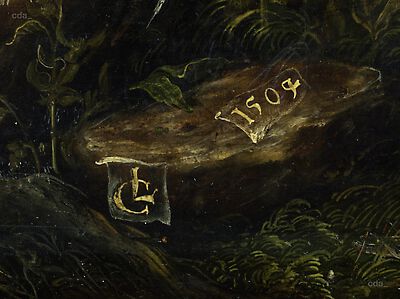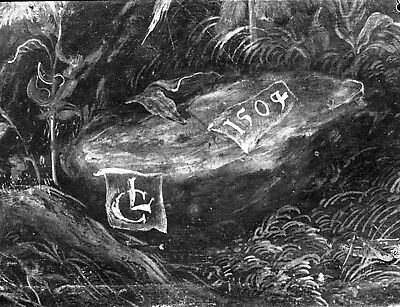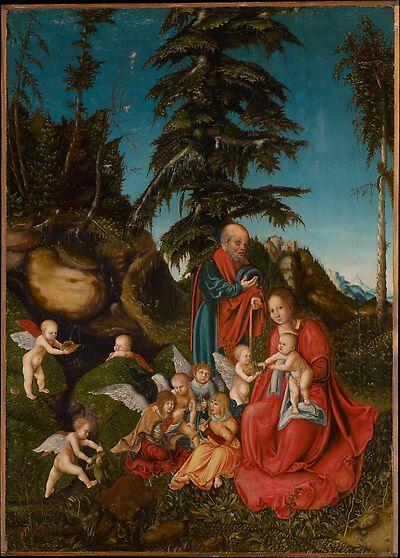The artist essentially applied pure hues of paint in two to four layers to achieved the desired effect. Colour mixtures can be found in the sky and the flesh paint.
The artist began by laying in the initial layer of the flesh paint. He chose a mid flesh tone consisting of a mixture of lead white, as is visible in the x-radiograph and a red pigment, presumably vermillion, and a small quantity of black.
This base tone appears to have been brushed beyond the contours indicated in the underdrawing and the final demarcation of the flesh paint fixed by the black underpainting of the background and the garments. The modulation of the flesh paint followed after a drying period during which the draperies were painted. The snail in the angel’s hand was probably executed together with the flesh paint as the artist has employed the mid flesh tone as the base tone. The area appears to have been modulated at a later stage, once the paint was dry.
The black underpainting was applied with a broad brush on the background, on Joseph’s coat, on the angels robes, on the Virgin’s undergarment and in the area of the trees.
Subsequently the draperies were executed beginning in the red areas. The layer structure is visible to the naked eye in both the Virgin’s and Joseph’s robe and in the angel’s dress. The artist employed two methods to achieve colour nuances. The robes of the Virgin and Joseph are a vibrant red. Here the highlights were applied in white paint, which as the x-radiograph shows is probably lead white on an orange reddish ground. The shadows were then added in black paint with a pointed brush and finally a red lake glaze of varying thickness was applied.
The angel’s dress as well as the sleeves of the Virgin’s dress, are a darker red and were by contrast painted over the black underpaint; modelled in white and then drawn together with a red glaze. As the red paint extends over the edge of the sheet of white paper in the angel’s hand it may be assumed that this was executed at the same time as the white highlights.
The light blue boarder was carried out before the shading in the flesh paint or the black shadow in the golden cape. The black inscription was carried out after the red robe, followed by the execution of the yellow areas. This was evident in the transition from the Virgin’s robe to the yellow dress of the angel with a flute. The light ground appears to have been used in the colour scheme. There was originally a light yellow paint layer over the areas with highlights. Presumably this was covered with a brown glaze, which is now only visible as a remnant above the right arm in front of the flute, under the green vegetation and beneath the left arm.
The shadows were probably indicated by the light grey underdrawing, which is visible through the translucent paint. Dots of black paint and shell-gold were employed to decorate the left arm and were applied considerably later once the underlying paint layer was dry. The golden robe of the angel sitting opposite exhibits a similar layer structure. Here the depth of the folds are applied in black paint directly over the ground and then covered with a thin brown glaze, which extends as far as the black hem of the coat. Pastos decorative ornaments or dots were applied in white paint over the entire surface of the coat. Subsequently parts of the coat were decorated with thin lines of shell-gold. A blue layer of paint was applied over the black underpaint on the lining of the coat. The fact that the paint layers are not blended suggests that the artist maintained a drying time, during which he worked on other parts of the painting. He continued with the white area of the scarf and the wings applying the paint rather thickly. The artist used a light blue admixture, and at times a grey consisting of blue, black and white pigments to modulate the shadows. He essentially worked wet-in-wet to create the wings of the angel on the top left.
Beginning with the white contours of the feathers, which were applied in thick paint he then applied a slightly transparent brown tone and black paint mixed with a small amount of blue pigment. The paint appears to be very medium rich, as the paint is frequently blended. A final red glaze was applied, which also covers the green glaze on the vegetation, indicating that the artist completed the wings after the vegetation and after a drying period. The outline at the top of the wings was applied in white paint, which was also employed for the curls of the hair. The wings of the angel holding a parrot were also painted wet-in-wet with blended bluish grey and white paint and brown glazes. In addition a red glaze was applied to the wings at the back. The artist employed the black underpaint to create the back wing of the angel wearing the golden coat. Here the contours of the feathers were indicated in white paint. It may be presumed that the painting process was continued at a later stage once the white paint was dry. The angel holding a strawberry has a white wing that was probably executed at the stage of the painting process described above. On the other hand the back wing exhibits an initial brown glaze layer, with subsequently applied green patches and black dots in imitation of a peacock’s feather. The upper part of the feather was applied over the lining of Joseph’s coat and in the lower part over the white wing, indicating that this wing was executed after the red robes. The rocky outcrop on the left side of the painting was initially indicated with a very thin dark brown layer of paint applied before the blue paint in the sky. The artist then continued with the execution of areas in blue paint before completing the rocky outcrop. Thus the blue wings of the angel with the flute were executed next as were those of the angel opposite him. Here the artist employed white paint over the black underpaint and then worked them up with blue paint. A similar process can also be observed in the blue robe of the angel with a flute. Here the upper part of the robe has a black layer of underpaint, which has been partially covered with blue paint. The lower part of the robe, whereas the lower half was held in reserve and does not exhibit the same black underpaint. Pink paint was used to indicate the folds and finally the shadows were executed in blue paint, which is partially covered by a black paint that was added later. This phenomenon can also be observed on Joseph’s coat and on his hat. Here the shadows of the folds were initially painted in black, however the areas of the highlights were held in reserve. An application of blue paint followed and subsequently the artist reinforced the spatial effect of the shadows with an additional application of black paint. In the hat the paint was dabbed on.
The sky was painted before the birch tree on the the right and before the other trees (already indicated in black) were completed. This explains the different grey values in the infrared reflectograph. The crown of the birch tree applied in an initial dark brown layer over the painted sky appears much lighter than the trees, which exhibit a black underpaint and were held in reserve.
It extends as far as the black underpaint of the bushes behind the Virgin on the right side of painting. The proportion of blue pigment in the mixture with lead white increases towards the top of the panel. The landscape on the left side of the panel was also executed in blue paint. Here the artist creates the form by employing varying thicknesses of paint, dabbed on and on the left applied with diagonal strokes, or by holding the white area in reserve and incorporating the ground. He only rarely applied a green glaze to emphasize certain details. This was applied later together with the glazes on the vegetation.
Finally the artist returned to completing the flesh paint. He modulated it with admixtures of the basic flesh tone using varying proportions of red, brown, black or white pigments. In areas of the cheeks, the chin, the nostrils and the eyes this brown tone was applied as a glaze to create the shadows. For the highlights on the forehead, the chin and the tip of the nose he employed the base tone with an addition of white. The outlines were emphasized by a line drawn with the brown paint used for the shadows. The eyes were painted over the base tone or over the brown tone of the shadows. First the black pupils, the contours and the eye lashes were painted, and then the highlights were applied around the pupils in an opaque white paint. The eyelids were partially emphasized with a red line. Finally a little blue paint was applied to the eye. The mouths were modulated with a light, orange-red and a dark red, which was applied as a glaze.
Then details like the open mouth painted in black or the teeth applied in thick paint were executed.
Beneath the top lip the artist used grey paint consisting of white, a little blue and black pigment to indicate the highlight bordering on the brown painted shadow. He forms the ears on the base tone with an initial layer in white paint for the highlights, and over this he applies the brown shadow tone and black paint to indicate the inner ear. The artist modulates the hands with thick white paint to indicate the highlights, and which are partially bound by the pink or brown areas of shadow. The fingers are described with brown contour lines. These stages were carried out in quick succession as the paint is at times blended, which has resulted is blurred transitions that appear to have been consciously calculated.
Joseph’s staff was painted at the same time with the same materials and in the same stages. The artist probably also painted the snail/shell, which is modeled in black and white paint at this point.
The wing of the angel sleeping exhibits an initial red shadow layer on top of which the artist applied black and green paint with a pointed brush. This was carried out at the same time as the vegetation. The flutes were painted after the robes were completed and the flesh paint was modulated. The initial layer was applied in a dark ochre tone and then in quick succession the highlights in a light ochre tone and the holes in black paint.
The artist added highlights in white paint to the rocky outcrop, which was already indicated with a brown glaze on the left in the background. He incorporated the black underpaint of the vegetation in the lower and right area in the modulation. Single blades of grass are partially emphasized in light yellow paint mainly on the black underpaint. Then a green glaze was applied over the whole area. The grassy area on the left hill was painted before the branches or needles on the tree in the centre of the painting. The green paint on the edges of some of the angels’ wings was probably carried out at the same time as the vegetation. The green vegetation has, as has already been mentioned, a black underpaint. The rocky foreground was painted over the black underpaint. Then the artist applied the blades of grass, the leaves, a butterfly and part of a tree trunk over this in white or ochre paint. Finally he applied a green glaze over the whole area with some highlights in white or a red glaze. The strawberries were also painted over the black underpaint with white highlights, a green glaze, a red glaze and some orange-red and white dabs of paint. The petals of the flowers were initially painted in pink paint on the green background. Then the artist applied a dark red glaze and finially indicated the highlights with a few white brushstrokes.
The butterfly was created employing a little blue paint in the wings and black around the eye and in the shadows. The tree stump on the left was painted in black paint with a white ring on the top.
The stone with the signature was created with brown paint which was partially applied as a glaze and incorporated the black underpaint over which the vegetation was painted. The signature and the date were probably applied after the painting was completed with a pointed brush in white paint.
It is not possible to tell whether the parrot held by the angel was executed at this time. Under the stereomicroscope it was possible to establish that it was painted after the green ground and the modulation of the flesh paint was dry, as the paint is not blended. The beak and the claws are painted in red and the eye is black. Its feathers are created with many small brushstrokes in red, white, black and green paint, which were applied in quick succession as the paint is partially blended, like in the tail.
The artist appears to have painted the trees from left to right and as such the roots of the tree on the left are covered by the branches of the large coniferous tree in the centre. Grey paint was applied over the sky to create the crown of the birch tree, while the trunk was painted wet-in-wet employing black and a toned white paint. The brushstrokes are clearly visible in the pastos paint. Highlights were applied in white and a final brown glaze was employed to reduce the white contrasts. The artist appears to have used a very soft brush to blend the wet paint. Subsequently the branches were added in dark brown paint and modulated with a reddish brown almost orange paint. A black underpaint was applied as an initial layer for the foliage. Single leaves were indicated in white or light yellow paint and then the whole area was covered with a green glaze. At the bottom edge beneath the angel with a snail there is a ring on a tree stump. The tree was modulated and details carried out in white, brown and red paint over an initial grey layer. The ring is black with white highlights. The houses in the background were executed in a thin glaze, probably at the same time as the trees in this area. The basic form was created with a wet-in-wet application of reddish white paint and completed with black, red and white. The coniferous tree in the centre of the composition exhibits an initial black underpaint, which in accordance with the underdrawing was applied over a large area. Highlights were added in white paint. A green glaze covers the whole area. Shadows were then in part indicated with black paint to emphasis the spatial depth. In other areas the artist worked in black and white, applying grey paint over the black underpaint and then subsequently white paint, which was partially blended and partially pastos, almost dabbed on. In a few areas along the edge he applied a further black layer and a subsequent green glaze. Finally using shell-gold the artist applied the contours of the angels‘ wings, the shell, the feathers of the parrot as well as the gold ornaments on the coat of the angel in the foreground and the yellow dress of the angel with the flute and the Virgin’s halo.
The hair does not appear to have been painted until this late stage as it extends over both the clothing and the background paint. The artist followed a repeated pattern. He applied the single curls of Joseph’s hair with a pointed brush on an initial light brown and slightly stripy layer. There are some green areas from the coniferous tree on the black or white hair. The Virgin’s hair was applied over a reddish brown initial layer. Single strands of hair were applied in white paint and black in the shadows. In addition at the back of the head the artist applied a dark brown glaze. This partially covers the gold lines of the halo. The hair of the angel holding the strawberries was initially painted in ochre coloured paint above which the curls were applied in black and white paint after the draperies.
